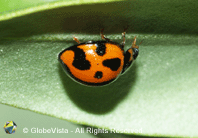Ladybirds
Order Coleoptera
Family Coccinellidae
Introduction
 Commonly known as ladybirds, ladybugs or lady beetles there are nearly 300 species of Ladybirds in Australia and over 4,000 worldwide. They belong to the Family Coccinellidae (meaning little red sphere). The Ladybird is actually a beetle and is one of the most economically important groups of beetles. They are lethal killers of crop pests such as aphids, scale insects and mealybugs.
Commonly known as ladybirds, ladybugs or lady beetles there are nearly 300 species of Ladybirds in Australia and over 4,000 worldwide. They belong to the Family Coccinellidae (meaning little red sphere). The Ladybird is actually a beetle and is one of the most economically important groups of beetles. They are lethal killers of crop pests such as aphids, scale insects and mealybugs.
The lifecycle of a ladybird
 The female Ladybird will lay her eggs in the egg clusters of other insects. When the larval ladybirds hatch they immediately feed on the eggs and larvae of the other insect. The female Ladybird lays clusters of eggs on the underside of leaves often near aphids. Once the egg has hatched, the larvae feeds on the eggs of insects such as aphids.
The female Ladybird will lay her eggs in the egg clusters of other insects. When the larval ladybirds hatch they immediately feed on the eggs and larvae of the other insect. The female Ladybird lays clusters of eggs on the underside of leaves often near aphids. Once the egg has hatched, the larvae feeds on the eggs of insects such as aphids.
It takes about three weeks for a Ladybird larva to become a pupa and within that time a Ladybird larva can feed on up to 350 aphids. The ladybird larvae look nothing like the familiar round shape of the adult ladybird, in fact, they are quite bizarre-looking more like a crocodile. After feeding the larvae attach themselves to vegetation and then contract into a dome shape (pre-pupa). The pre-pupa hardens to become a pupa. Inside, metamorphosing begins, with the tissues reorganizing themselves.
The larva pupates for about week before emerging as an adult. The adult emerges with no pattern and little colouring (pale yellow) on their dome-shaped bodies. However, the bodies eventually develop into a wide variety of colours including red, orange, amber, pink, yellow and black and the body can have between 0- 20 spots.
Habitat of the Ladybird
Ladybirds live on plants especially ones that are infested with aphids. During spring the Ladybird will lay her eggs on plants with aphids so that her offsprings will have a smorgasbord of food when they hatch.
Facts About Ladybirds
 The adult Ladybird is carnivorous and will feed on both eggs and larvae of common pest insects and also on nectar and pollen. They use their mandibles for chewing. The adults can also excrete a repulsive smelling yellow discharge (fluid) from its leg joints as a defense mechanism against predators. The fluid is actually their blood. The fluid can stain and leave a long-lasting smell on the hands of humans who attempt to pick them up. The bright colouring of ladybirds is also thought to warn would-be predators that they are poisonous.The ladybird’s main predators are wasps and weevils. The adult ladybirds hibernate together in large numbers through the winter (known as over-wintering), sheltering in thick vegetation, under tree bark or inside sheds. This is the best time for them to be harvested as they are in a very deep sleep.
The adult Ladybird is carnivorous and will feed on both eggs and larvae of common pest insects and also on nectar and pollen. They use their mandibles for chewing. The adults can also excrete a repulsive smelling yellow discharge (fluid) from its leg joints as a defense mechanism against predators. The fluid is actually their blood. The fluid can stain and leave a long-lasting smell on the hands of humans who attempt to pick them up. The bright colouring of ladybirds is also thought to warn would-be predators that they are poisonous.The ladybird’s main predators are wasps and weevils. The adult ladybirds hibernate together in large numbers through the winter (known as over-wintering), sheltering in thick vegetation, under tree bark or inside sheds. This is the best time for them to be harvested as they are in a very deep sleep.
Ladybirds as Pest Controllers
 Some Eucalypt plantations in Australia rely on Ladybirds to control insect pests such as the Eucalyptus leaf beetle. Several companies in Australia breed Ladybirds for growers who want to control insect pests without using chemical sprays.
Some Eucalypt plantations in Australia rely on Ladybirds to control insect pests such as the Eucalyptus leaf beetle. Several companies in Australia breed Ladybirds for growers who want to control insect pests without using chemical sprays.
In the 1880’s, the Australian Ladybird was introduced into California (U.S.A.) by the California Citrus Growers to control the citrus pest the Cotton Cushion Scale insect that had originally been imported from Australia. The scale insects had been killing large groves of lemon and orange trees. The orchard owners released thousands of Australian ladybirds resulting in the eventual eradication of the pest. The Australian Ladybird is still used to control crop pests in California.
The Australian Ladybird was also exported to Europe to help control insects that were attacking flowers and vegetables grown in glasshouses.
